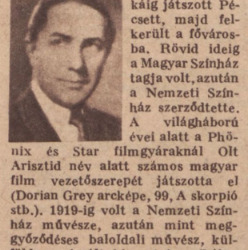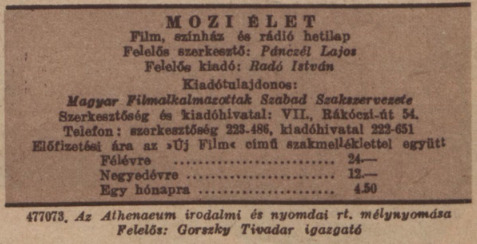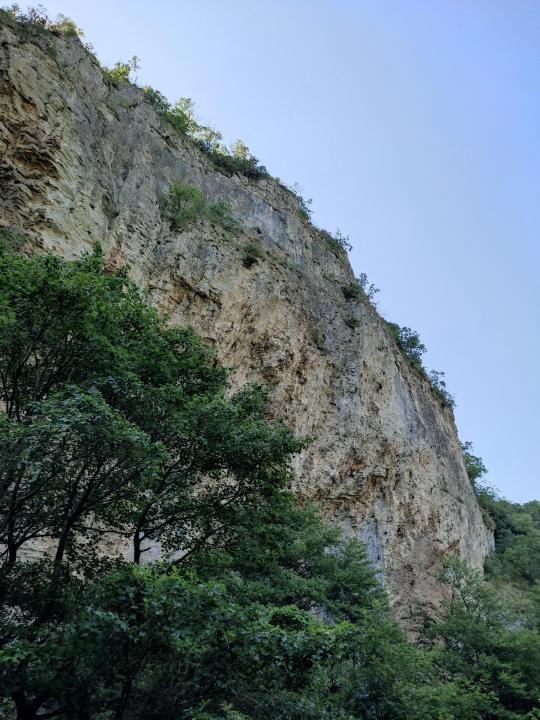# Caraș-Severin County
Explore tagged Tumblr posts
Text

For the 18th time in a row, the monumental cross on Muntele Mic peak, Caraș-Severin county (Romania), became a place of spiritual rest on the feast of the Exaltation of the Holy Cross. Photo credit: Diocese of Caransebeș / Darius Herea
40 notes
·
View notes
Text

I wasn’t feeling my art today, so I opted to translating. The Mozi Élet magazine had a featured star segment at the very end, either homegrown or Hollywood, and as Béla bá is both that’s two birds with one stone I guess. It kind of looks like an obituary, so I left the Mozi Posta part in, but I don’t think it’s helping lol.
Happy Birthday Béla bá~!! I’m sorry that this is all you are getting from me today. I’m dying.
Béla Lugosi, his family name: Béla Blaskó was born 1888 (Translator's notes: 1882 actually.) on October 20th at the Krassószörény county Lugos (Translator’s notes: Now Caraș-Severin County Lugoj and is part of Romania.). He started his theatrical career at the countryside, he played for a long time at Pécs, then moved up to the capital. For a short while he was part of the Magyar Színház (Hungarian Theatre), then the Nemezti Színház (National Theatre) contracted him. During the years of the World War he worked at the Phönix (Phoenix) and Star film studios and under the name of Arisztid Olt played the leading roles in many Hungarian movies (Dorian Grey arcképe (The picture of Dorian Grey), 99, A skorpió (The scorpion), etc.). He was an artist at the Nemzeti Színház until 1919, then after as a convinced left-leaning artist, emigrated, and left for America, where after a few years became one of the many well-known theatre and film actors. His fame came from Bram Stoker Irish english writer’s famous novel Dracula’s stage adaptation where he played the leading role. He later played the same role in film as well and from then on he appeared in many grand-guignol movies. His most known movies are: Drakula (Dracula), Chandu, A fekete teve (The black camel), Vámpírasszony (Translator’s notes: I’m unsure which movie this is, as it is not a direct translation of the title. It’s “Vampire Woman” and my best guess in this case is Mark of the Vampire.), Sárga bestia (Translator’s notes: Again I don’t know which movie this could be. The direct translation of the title is “Yellow Beast”.), Borzalmak szigete (Translator’s notes: The title that’s given is “Island of Horrors”, but to my knowledge Island of Lost Souls was actually one-to-one translated as Elveszett Lelkek Szigete.), Frankenstein fia (Son of Frankenstein), Gorilla (The Gorilla), Frankenstein visszatér (Translator’s notes: There is no “Frankenstein Returns”, so I’m assuming it’s Ghost of Frankenstein.), Kísértetbrigád (Translator’s notes: Again no direct translation works for “Spook Squad”, yeah let that sink in… I’m guessing Spooks Run Wild??), A farkasember (The Wolf Man), etc. (Source: Mozi Élet 1947, 48)
The end was messy I won’t lie, I really don’t know which titles can be which. Also some may say, that not all of those are ones that one would think as his most known movies. And I agree, but as to my knowledge The Black Cat, The Raven, and other bigger horror movies were banned or heavily censored, so I’m guessing that’s why they are not listed.
Anyways feel free to submit your questions, queries, thirst letters to the Movie Post. (I don’t think the address still works as the magazine has been discontinued and the guy in charge is probably dead, but feel free to try.)

13 notes
·
View notes
Photo

Natural landscape in Bozovici, Caraș-Severin county, România [3000 x 4000][OC]
10 notes
·
View notes
Photo

Bigăr, Caraș-Severin County, Romania
by Nᴏʀʙᴇʀᴛ Lɪᴇsᴢ from Deutschland
Source | Google Maps
#Romania#Wanderlust#Caraș-Severin#Bigăr#Photography#Travel#Caraș-Severin County#Berzasca#Destinations#Landscapes#Landscape#Nᴏʀʙᴇʀᴛ Lɪᴇsᴢ#Izvor#Waterscape#Cataracta#Cascada#Vandfald#Verde#Langzeit#Slap#Sehnswürdigkeit###Vízesés#Wodospad
40 notes
·
View notes
Text
Nature, Earthquakes, Romania
Seismic hazard for Romania from the Global Seismic Hazard Assessment Program (GSHAP). 455 July 10 AD. It destroyed several towns and villages in Transylvania. C. 543 AD. A 7.5 magnitude earthquake with the epicenter in Dionysopolis, Dobrich Province, Bulgaria. Large tsunami on the Dobrujan shore of the Black Sea. The Roman fortress of Capidava, Constanța County, is destroyed. 815 August AD.…

View On WordPress
#1977#2.20 pm#7.5#Album Oltardianum# Adjud# Caraș-Severin County# Cluj County# Dobrich Province# Focșani# năruja# Slovakia# southern Germany# Szatmár County# Timiș County#Balkan#Banloc#black sea#Brașov#Brăila#București#bug#Bulgaria#byzantine#capidava#carei#carlton bloc#carpathians#Chișinău#Constanta#Constantia
0 notes
Text
"Maybe you didn't know, but nowadays, the village Lindenfeld is an abandoned village. It is located in the Semenic Mountains, Caraș Severin County. The village was founded in 1828. And the last inhabitant died in 1998. Nobody lives there anymore. Everything is in ruins."
More informations here:
https://prinbanat.ro/en/lindenfeld-the-abandoned-village/
-Adrian Fahrenheit Țepeș



28 notes
·
View notes
Photo

By Ionut_Petrea
Izvorul Bigăr, Bozovici, Caraș-Severin County, Romania
#romania#europe#travel#landscape#nature#central europe#green#waterfall#caras severin county#bozovic#izvorul bigar#bigar waterfall#ionut petrea
21 notes
·
View notes
Photo









mountain architecture in Romania
(click for captions!)
bonus under read more

Church Saint Michael from Cisnădioara - the oldest monument of architecture in a purely Romanesque style in all Transylvania.
221 notes
·
View notes
Photo

Bigăr Cascade Falls, Caraș-Severin County, Romania [OC][4608x2592] via /r/EarthPorn https://ift.tt/3tA5D9Q
0 notes
Photo

Krashovani or Kraševski Hrvati in Romania The Krashovani (Romanian: Carașoveni, Croatian: Krašovani) are a South Slavic community inhabiting Carașova and Lupac in the Caraș-Severin County within Romanian Banat. They are regarded as and predominantly self-identify as Croats. They are Roman Catholic by faith and speak the Torlakian dialect Their dialect is regarded a sub-dialect of the Torlak dialect,a transitional dialect spoken in southeastern Serbia, westernmost Bulgaria and northeastern Macedonia. Their ancestors first settled Carașova in the 13th and 14th centuries from northwestern Bosnia. They formed a community in the northern plateau of the Caraș river, in seven villages, the oldest, Carașova, being mentioned in the 13th and 14th centuries while the rest are first mentioned in the 17th century.S erbian ethnographer Jovan Cvijić concluded that the community was "very old settlers with origin in Crna Reka who were Catholicised"; Stanko Žuljić claims that their origin is in Turopolje, in Croatia. The Carașoveni were considered Bulgarians by some Bulgarian scientists in the first half of the 20th century (such as G. Cibrus, M. Mladenov, K. Telbizov, and T. Balkanski), partially based on their view that Torlakian-speakers are ethnically Bulgarians.According to the Austrian population census there were over 10,000 Carașoveni in Banat. In the 1847 census over 10,000 people declared as Carașoveni. In 1896 the Austro-Hungarian census around 7,500 Carașoveni were listed. The same was stated by the authorities of the Kingdom of Romania in 1940. Their number dropped to 2,775 in 1992. Ever since the Romanian Revolution, the government of Romania has awarded special minority status and privileges to its ethnic Serb citizens. The Democratic Union of Serbs and Krashovani of Romania (Uniunea Democratică a Sârbilor si Carașovenilor din România) was founded in 1992.
88 notes
·
View notes
Photo

Check out this great shot from Caraș-Severin County, Romania. with ShutterBee app.
5 notes
·
View notes
Photo

Bigăr Cascade Falls, Caraș-Severin County, Romania [OC][4608x2592]
3 notes
·
View notes
Photo




Băile Herculane, Romania
Băile Herculane (Latin: Aqua Herculis) is a town in Romanian Banat, in Caraș-Severin County, situated in the valley of the Cerna River, between the Mehedinţi Mountains to the east and the Cerna Mountains to the west, elevation 168 meters.
The spa town of Băile Herculane has a long history of human habitation. Numerous archaeological discoveries show that the area has been inhabited since the Paleolithic era. The Peștera Hoților (Cave of the Thieves), contains multiple levels, including one from the Mousterian period, one from the Mesolithic period (late Epigravettian) and several from the later Neolithic periods.
Legend has it that the weary Hercules stopped in the valley to bathe and rest. Unearthed stone carvings show that visiting Roman aristocrats turned the town into a Roman leisure center. Six statues of Hercules from the time have been discovered. A bronze replica of one of them, molded in 1874, stands as a landmark in the town center. Austrian and Ottoman troops clashed here after the Ottoman victory in the battle of Mehadia on 30 August 1788. The Ottomans won the skirmish, took the town on 7 September 1788 and advanced to Caransebeș. It was retaken by the Austrians at the end of September 1789.
In modern times, the spa town has been visited for its supposedly natural healing properties: hot springs with sulfur, chlorine, sodium, calcium, magnesium and other minerals, as well as negatively ionized air.
#aka one of my fave places on earth#there's so much forest and it's so isolated and quiet and the hiking trails are fantastic imo#i selfishly don't want it to become more popular.#romania#baile herculane#mine#visual
44 notes
·
View notes
Note
how are croatian or slovenian minoritized though?
Croatian:
Croatian is native to Croatia, Bosnia and Herzegovina, Serbia (Vojvodina), Montenegro, Romania (Caraș-Severin County), Slovenia, and also has a significant diaspora.
In Caras-Severin education, signage and access to public administration and the justice system are provided in Croatian, alongside Romanian, but the Croats from Slovenia and the diaspora cannot access education or media in their language. Take into account the fact that, in Slovenia, Croats are the 2nd largest minority.
In Slovenia, speakers of BCS and Macedonian are commonly discriminated against for their language, since it is considered to be “lesser” or “incorrect”.
Slovene:
Slovene is native to the Slovene lands, which include:
Slovenia, where it is the official language
parts of Italy, Austria, and Hungary where Slovene is recognised as a minority language,
a part of Croatia, where it is not recognised.
this means that the Slovene people from outside Slovenia cannot access education nor media in their mother tongue.
The Slovene minority in Italy was persecuted during the fascist regime. Between 1923 and 1943, all public use of Slovene language in these territories was strictly prohibited, and Slovene language activists were persecuted by the state.
After 1920, a less severe policy of Germanization took place in the Slovene-speaking areas of southern Carinthia which remained under Austrian administration.
After 1938, the use of Slovene was strictly forbidden in Carinthia, as well. This accelerated a process of language shift in Carinthia, which continued throughout the second half of the 20th century (according to the Austro-Hungarian census of 1910, around 17% of inhabitants of Carinthia spoke Slovene in their daily communication; in 1951, this figure dropped under 10%, and by 2001 only 2.8%)
During World War II, Slovenia was divided among Fascist Italy, Nazi Germany, and Hungary. Each of the occupying states tried to either discourage or entirely suppress the Slovene language.
many will also say Slovene was in a dispriviledge posotion during teh times of Yugoslavia.
Even nowadays, Slovene isn’t perceived positively by some people in Austria and Italy.
example: the parts of Italy and Austria that are part of the Slovene lands, there are bilingual road signs (Italian/German and Slovene), and the Slovene ones have been vandalized many times.
Luckily, neither Croatian nor Slovene are endangered nowadays, but they have been minoritized.
Anyways, I’m not Croat or Slovene so I’m basing this on the research I did before doing the moodboards. I’d recommend asking peopl from these linguistic communities.
87 notes
·
View notes
Photo

Happy #easter 💐 #flowers #photography (at Caraș-Severin County)
1 note
·
View note
Photo

S-a arătat puțin soarele 😊 (at Caraș-Severin County) https://www.instagram.com/p/BoJRG4xBpP2/?utm_source=ig_tumblr_share&igshid=1ndtonbib0xnx
0 notes